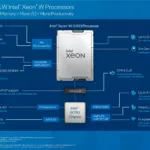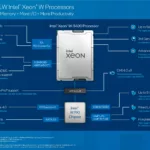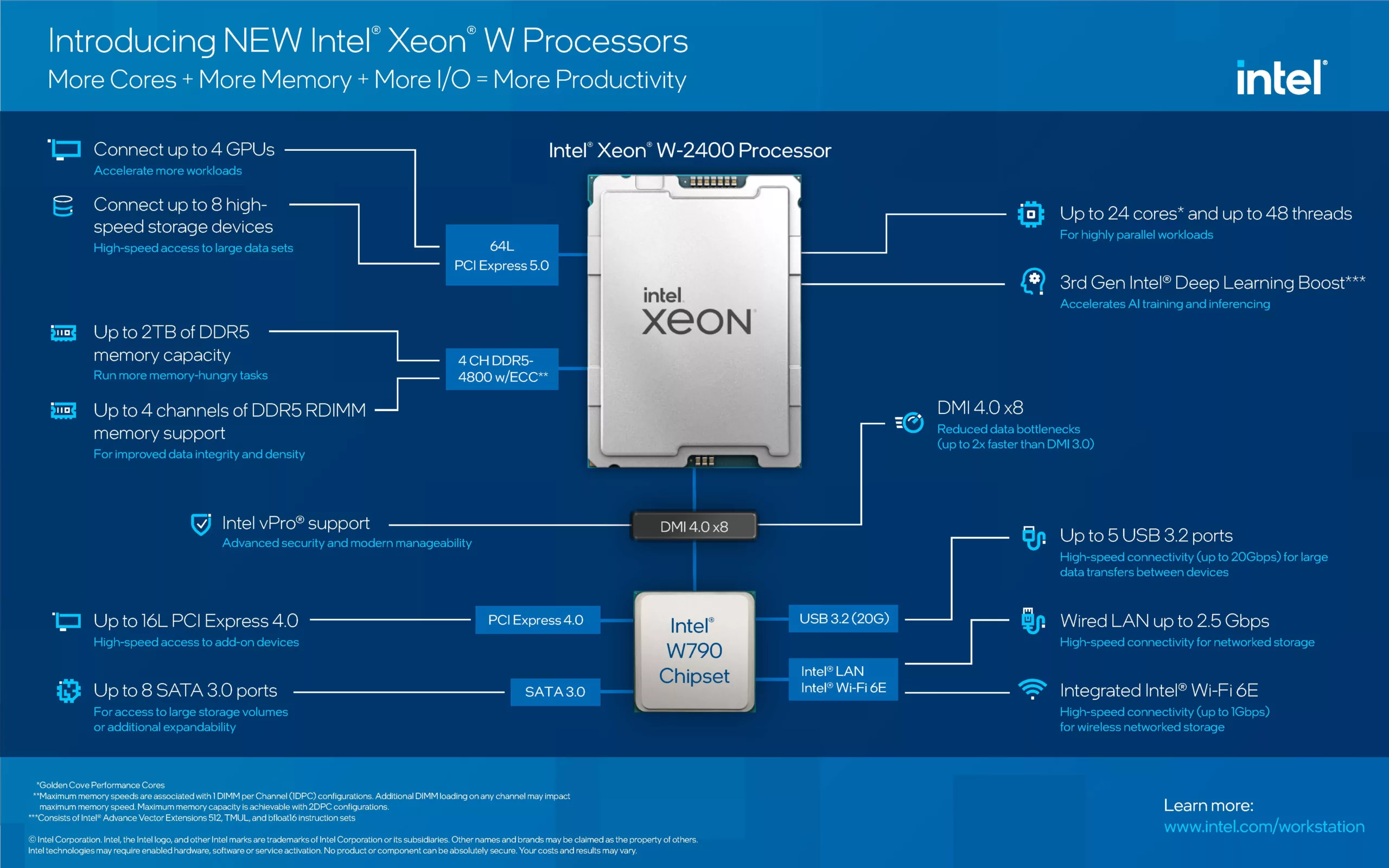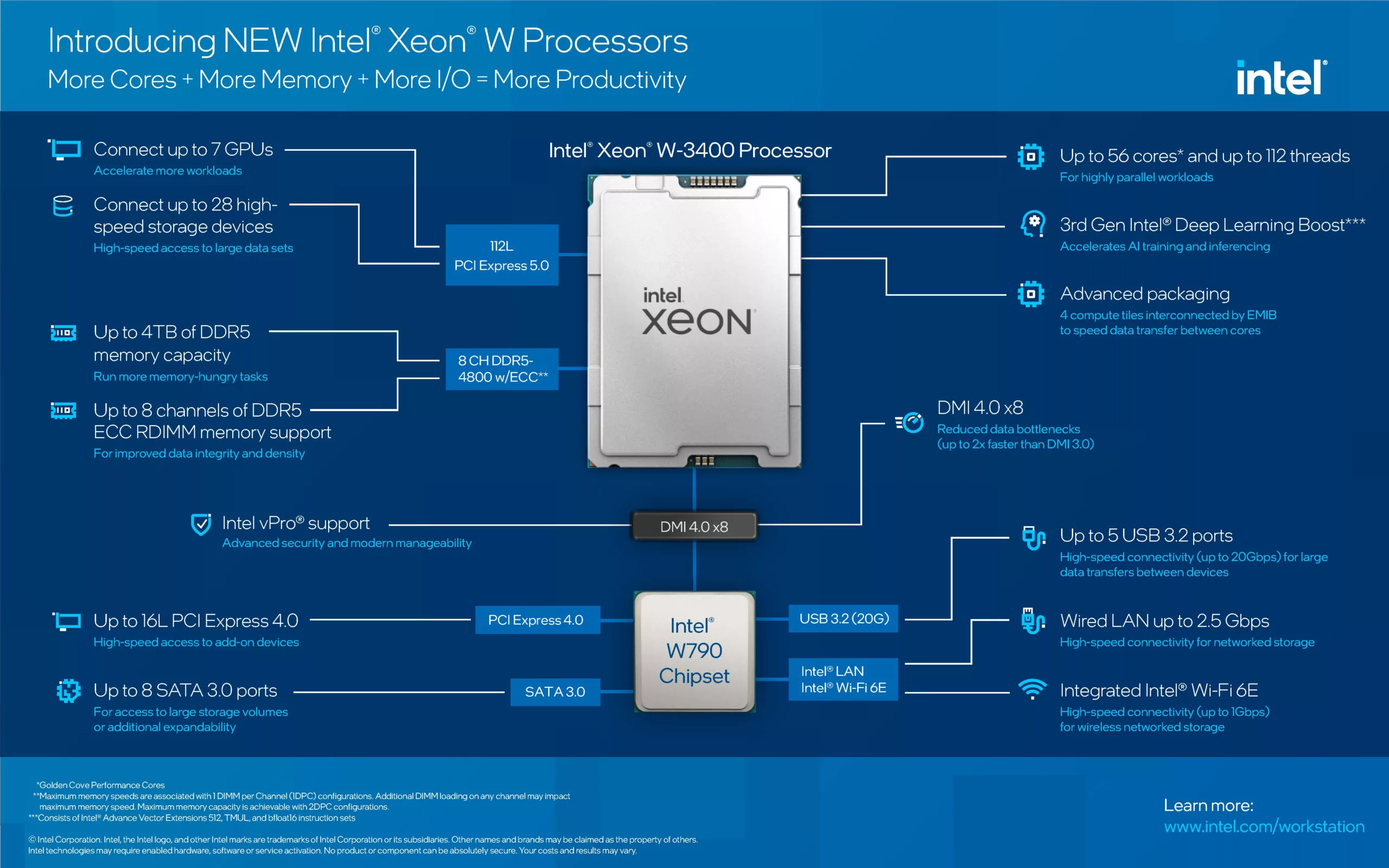Table of Contents
Introduction
On February 15th 2023, Intel announced the launch of two new families of Xeon processors: the W-2400 and W-3400 series. Both bring new and potentially exciting features to Intel’s workstation processor lineup:
- Xeon W-3400 is a replacement for the previous W-3300 line, but with substantially higher core counts and improved performance. They feature eight-channel memory controllers, as previous generations had, with up to 56 cores (112 threads with Hyperthreading).
- Xeon W-2400 represents Intel’s re-introduction of a high-end desktop (HEDT) processor, which has been absent since their Core X line faded from the spotlight a few years ago. These are more affordable than the W-3400 series and equipped with quad-channel memory controllers, but only go up to 24 cores / 48 threads.
One major improvement with this generation is the move from DDR4 to DDR5, while still maintaining the use of ECC Registered memory modules. This change also comes with a new socket, meaning a new chipset and motherboards too – so these are not usable as drop-in upgrades to existing workstations.
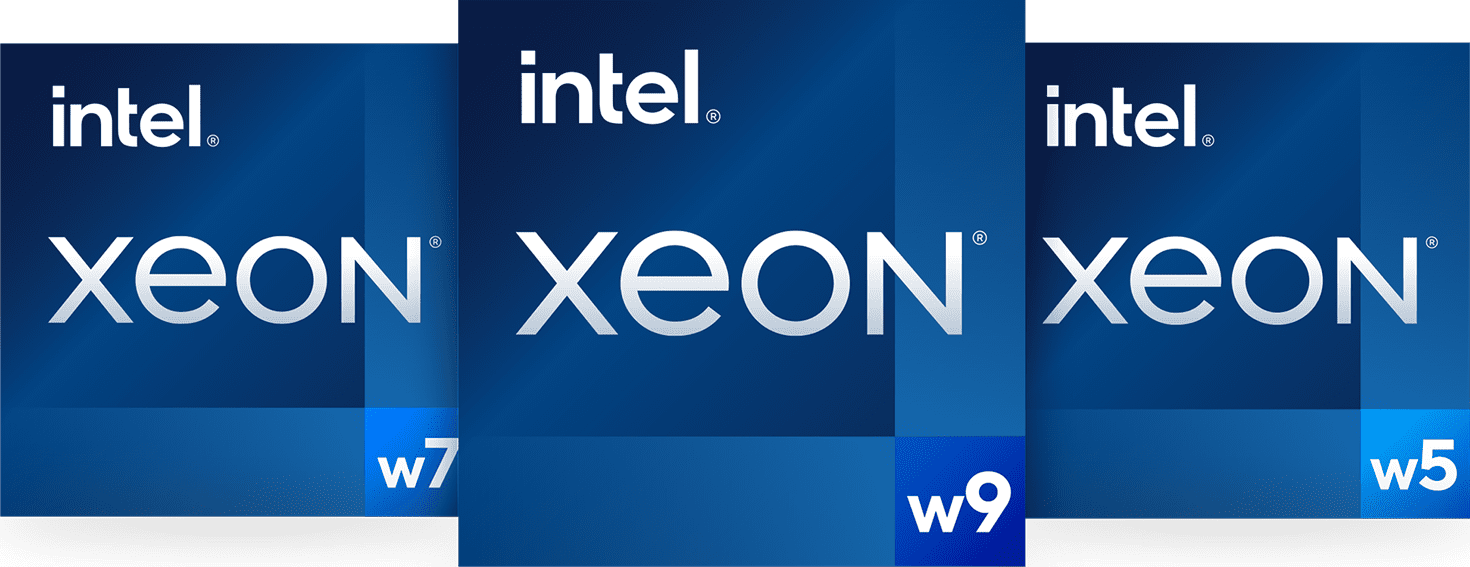
Differences Between Xeon W-2400 & W-3400
Here is a chart showing the differences between Intel’s W-2400 and W-3400 processor families described above, along with other variants between the two like PCI-Express lane count and base power usage:
| Xeon W Overview | Intel Xeon W-2400 (Mainstream Workstation Processors) | Intel Xeon W-3400 (Expert Workstation 1S Processors) |
|---|---|---|
| Socket | LGA 4677 | LGA 4677 |
| CPU PCIe Lanes | 64 | 112 |
| Memory Channels | 4 | 8 |
| Max Cores/Threads | 24/48 | 56/112 |
| Base Power | 110 – 225W | 270 – 350W |
| Max Memory | 2TB DDR5 | 4TB DDR5 |
| Overclocking | Select Models – Denoted With “X” in Model # | Select Models – Denoted With “X” in Model # |
As you can see, the W-2400 line is mostly a trimmed-down version of the W-3400 processors. Half the memory channels and maximum memory capacity, a bit less than half the maximum core count, and a bit more than half the PCIe lanes. There are also a number of similarities, though! Both lines use the LGA 4677 socket, and thus are compatible with the same CPU coolers – but the heat spreaders are physically different, so you need a different carrier to adapt each line to the base of the cooler.
Because of the shared socket and underlying design, CPUs from each line can also use the same chipset (W790) and work with the same motherboards. However, some motherboards are designed with the W-2400 series in mind – and putting a W-3400 chip in those will result in half the CPU’s memory channels and a lot of its PCI-Express lanes going unused. The halved memory bandwidth in particular can impact the performance of some real-world applications, so it is important to note.
On the other hand, putting a Xeon W-2400 series processor into a board built for the W-3400 will result in some of the slots on the board not working. Since the W-2400s have half as many memory channels, half of the RAM slots will not function – limiting the amount of memory that can be installed. Likewise, some of the PCI-Express slots and possibly M.2 sockets will be non-functional which in turn limits expansion capability.
Overclocking
The last thing we want to make sure to point out is that overclocking is now a supported feature for some Xeon W models. Across both the W-2400 and W-3400 families, any model number ending in “X” has an unlocked clock multiplier. This naming hearkens back to the Core X lineup from a few years ago, which sported designations like “Core i9 10900X” and were likewise overclockable.
In our opinion, however, overclocking is contrary to one of the main goals of a workstation-class product (stability and reliability). If you are willing to assume the risks, it can be a viable way to get some “free” performance. Unfortunately – again, in our opinion – many motherboards ship with features like Multi-Core Enhancement (MCE) enabled. This particular setting allows the system to run all the cores at the maximum rated Turbo Boost frequency, rather than lowering the frequency based on how many cores are being used. Intel considers this a form of overclocking, and it definitely causes CPUs to run hotter than would otherwise be expected when many of the cores are under heavy load at the same time.
Xeon W-2400 vs W-3400 Infographics
Here is a gallery of charts provided by Intel, which demonstrate the functional differences that these two processor families have:
Full Xeon W-2400 and W-3400 CPU Lineup
Intel tends to provide a very broad product portfolio for Xeons, and these new lines are no different with eight models in the W-2400 line and seven in the W-3400 line. This results in a long list of CPUs, which we have shown along with basic specifications in the table below. If you want to see the full specs of these new Intel Xeon CPUs, we recommend checking out the Intel Ark page for Xeon W Processors.
| Intel Xeon | Cores/ Threads | Cache (L3) | Max Clock | Base Clock | Max Memory Speed | Unlocked | Power (Base/Max) | MSRP |
|---|---|---|---|---|---|---|---|---|
| w9-3495X | 56/112 | 105MB | 4.8GHz | 1.9GHz | DDR5 4800 | Yes | 350/420W | $5,889 |
| w9-3475X | 36/72 | 82.5MB | 4.8GHz | 2.2GHz | DDR5 4800 | Yes | 300/360W | $3,739 |
| w7-3465X | 28/56 | 75MB | 4.8GHz | 2.5GHz | DDR5 4800 | Yes | 300/360W | $2,889 |
| w7-3455 | 24/48 | 67.5MB | 4.8GHz | 2.5GHz | DDR5 4800 | No | 270/324W | $2,489 |
| w7-2495X | 24/48 | 45MB | 4.8GHz | 2.5GHz | DDR5 4800 | Yes | 225/270W | $2,189 |
| w7-3445 | 20/40 | 52.5MB | 4.8GHz | 2.6GHz | DDR5 4800 | No | 270/324W | $1,989 |
| w7-2475X | 20/40 | 37.5MB | 4.8GHz | 2.6GHz | DDR5 4800 | Yes | 225/270W | $1,799 |
| w5-3435X | 16/32 | 45MB | 4.7GHz | 3.1GHz | DDR5 4800 | Yes | 270/324W | $1,589 |
| w5-2465X | 16/32 | 33.75MB | 4.6GHz | 3.1GHz | DDR5 4800 | Yes | 200/240W | $1,399 |
| w5-3425 | 12/24 | 30MB | 4.6GHz | 3.2GHz | DDR5 4800 | No | 270/324W | $1,189 |
| w5-2455X | 12/24 | 30MB | 4.6GHz | 3.2GHz | DDR5 4800 | Yes | 200/240W | $1,049 |
| w5-2445 | 10/20 | 26.25MB | 4.6GHz | 3.1GHz | DDR5 4800 | No | 175/210W | $839 |
| w3-2435 | 8/16 | 22.5MB | 4.5GHz | 3.1GHz | DDR5 4400 | No | 165/198W | $669 |
| w3-2425 | 6/12 | 15MB | 4.4GHz | 3.0GHz | DDR5 4400 | No | 130/156W | $529 |
| w3-2423 | 6/12 | 15MB | 4.2GHz | 2.1GHz | DDR5 4400 | No | 120/144W | $359 |
Closing Thoughts
Compared to the previous W-3300 line, the new W-2400 processors are a bit less expensive per core at the top end, and pretty on par around the 12-core mark. Interestingly, Intel is providing a number of lower-end models this time around – all the way down to a 6-core model for just $359. Although we are not planning on carrying models that low, they could be a viable option for workloads where the CPU primarily functions as a traffic controller. Being able to get support for 64 PCIe lanes or terabytes of RAM on a $359 processor is unheard of.
We will note, however, that MSRP can be misleading for this type of product, as these CPUs are intended to primarily be sold as a part of an entire workstation and not as individual parts. Because of that, pricing can change based on numerous deals system integrators may have access to, but are also impacted by the markup applied by those same integrators.
In terms of specs, the W-2400 CPUs are very similar to their W-3400 counterparts at the same core count, although it is interesting how much lower the wattage is. The w5-2455X, for example, is almost identical to the w7-3425 in terms of base specs, only with a dramatically lower power draw. True, it has fewer PCIe lanes and memory channels, but a 70-84W difference is pretty significant if you don’t need those additional features.
All in all, the new Xeon W-2400 and W-3400 processors are a welcome addition to Intel’s workstation lineup and worthy replacements for both the Xeon W-3300 and the long-lost Core X-Series.


